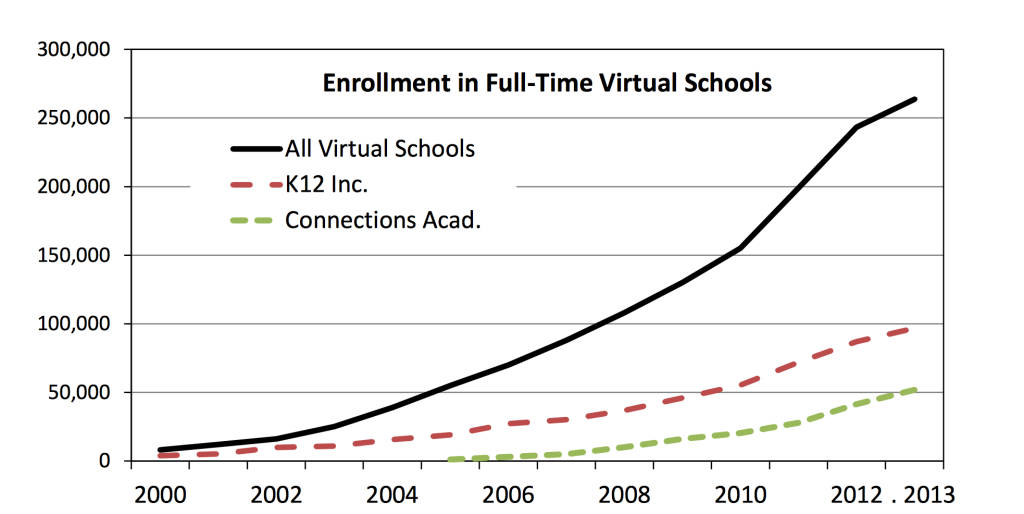 One of the most frustrating characteristics of the education reform political climate is the correlation between a specific policy's popularity and the absence of any reliable evidence supporting its effectiveness. Whether its overtesting, budget cuts, merit pay, or vouchers, it seems the weaker the case, the greater likelihood that idea proliferates.
One of the most frustrating characteristics of the education reform political climate is the correlation between a specific policy's popularity and the absence of any reliable evidence supporting its effectiveness. Whether its overtesting, budget cuts, merit pay, or vouchers, it seems the weaker the case, the greater likelihood that idea proliferates.
Add cyber schools to the list. They've been around for a couple of decades, but it wasn't until the past few years that more lawmakers increasingly looked to virtual schools as an attractive option to bricks-and-mortar public schools. Supporters argue that they provide students with a more flexible, individualized curriculum, are far less expensive than traditional schools, and can produce greater student achievement. The problem is that these are more assumptions than facts grounded in reliable data.
As a new study by the National Education Policy Center (NEPC) concludes, full-time virtual schools - many of them organized as charters - continue to lag behind traditional public schools on graduation rates, Adequate Yearly Progress (AYP), and state performance rankings.
"Despite the considerable enthusiasm for virtual education, there is little credible research to support virtual schools' practices or to justify ongoing calls for ever greater expansion," the report states.
The authors concede that the available data is limited, which may make their findings less than definitive - but "there is not a single positive sign from the empirical evidence presented here."
Although they still represent a relatively small percentage of school choice options, cyber schools have grown steadily over the past decade. There are currently 400 full-time virtual schools operating in thirty states with a total student enrollment at around 260,000. Connections Academy and K12 Inc, two for-profit companies, account for 57 percent of these enrollments.
 Estimated Enrollment Trends in Full-Time Virtual Schools. (National Education Policy Center)
Estimated Enrollment Trends in Full-Time Virtual Schools. (National Education Policy Center)
This impressive growth, however, should not mask the fact that, whether its the lack of accountability structures, the difficulty in recruiting and training high quality teachers, concerns over curriculum, or the underrepresentation of minority students, cyber schools are facing major challenges.
Here's what the available data tell us:
- In 2013-14, of the 285 virtual schools that were rated by state performance measures, only 41 percent were deemed "academically acceptable."
- In 2011-12, virtual charter schools scored 22 percentage points lower on AYP than bricks-and-mortar public schools.
- The on-time graduation rate for virtual school students in 2013-14 was barely half the national average.
- The average student-to-teacher ratio is twice that of the nation's public schools.
- Little progress has been made toward the development of requirements for the preparation, certification, and licensure of online teachers.
- Virtual schools serve significantly fewer minority students, fewer lower income students, and fewer students with disabilities than traditional public schools.
According to the NEPC report, state laws governing the funding and accountability of cyber schools tend to be vaguely-worded, incomplete and are often not enforced when data is available that suggests a problem exists. The report points to examples in Michigan, Pennsylvania and Tennessee where aggressive lobbying by for-profit providers circumvented legislative attempts to slow down cyber school expansion in the face of evidence that the schools were underperforming.
The good news is that lawmakers in a few states are taking a harder look. The NEPC report singles out the Pennsylvania for the steps it has taken to rein in the industry's profiteering and to identify tighter accountability measures for student learning.The record of Pennsylvania's 14 cyber charter schools was so abysmal that the state denied all applications for additional schools in 2013 and 2014.
Similar progress on a national scale, however, has yet to be seen.
"The rapid expansion of virtual schools is remarkable given the consistently negative findings regarding student and school performance," the report concludes. "New opportunities are being defined and developed largely by for-profit entities accountable to stockholders rather than to any public constituency."




